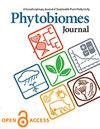Interactive Effects of Soybean Cyst Nematode, Arbuscular-mycorrhizal Fungi, and Soil pH on Chlorophyll Content and Plant Growth of Soybean
IF 2.6
3区 生物学
Q2 MICROBIOLOGY
引用次数: 4
Abstract
Nutritional deficiency chlorosis especially iron-deficiency chlorosis and soybean cyst nematode (SCN) limit soybean yield. Arbuscular mycorrhizal fungi (MF) generally have beneficial effects on plant growth. The interactive effects of SCN, MF, and soil pH on leaf chlorophyll content (LCC) and growth of soybean were examined in a greenhouse experiment. The experiment was a randomized complete block design with three factors: SCN population densities, MF inoculation, and soil pH levels. SCN reduced LCC, and the effect increased with increasing time during 5-9 weeks after planting, especially in the high pH (8) soil. MF increased LCC in low pH (5.6) soil regardless of SCN population density and in the high pH soil without SCN. However, MF reduced LCC if both pH and SCN population density were high. The high SCN population density (inoculation 10,000 eggs/100 cm3 soil) reduced soybean shoot weight in all soils regardless of MF. MF increased shoot weight at pH 6.9 and pH 8 but not at pH 5.6. When MF was present, shoot weight was generally highest at pH 6.9. At high SCN when MF was absent, plant growth was better in pH 5.6 than pH 6.9 and 8 soils. This study demonstrates that SCN causes greater damage to soybean when interacting with high pH, and MF had a beneficial effect on soybean growth regardless of SCN infection in all pH soils, in spite of the negative effect of MF on LCC around 5-9 weeks after planting in high pH soil at high SCN population density.大豆囊性线虫、丛枝菌根真菌和土壤pH对大豆叶绿素含量和植株生长的交互作用
营养缺乏性黄化,特别是缺铁性黄化和大豆胞囊线虫病限制了大豆产量。丛枝菌根真菌(MF)通常对植物生长有有益的影响。在温室试验中,研究了SCN、MF和土壤pH对大豆叶片叶绿素含量和生长的交互作用。该试验采用随机完全区组设计,有三个因素:SCN种群密度、MF接种和土壤pH水平。SCN降低了LCC,并且在种植后5-9周内,这种作用随着时间的增加而增加,尤其是在高pH(8)土壤中。在不考虑SCN种群密度的低pH(5.6)土壤和不含SCN的高pH土壤中,MF增加了LCC。然而,如果pH和SCN种群密度都很高,MF会降低LCC。高SCN群体密度(接种10000个鸡蛋/100 cm3土壤)降低了所有土壤中大豆的茎重,而不考虑MF。MF在pH 6.9和pH 8时增加了茎重,但在pH 5.6时没有增加。当MF存在时,芽重通常在pH 6.9时最高。在没有MF的高SCN条件下,pH 5.6的土壤比pH 6.9和8的土壤生长更好。本研究表明,SCN在与高pH相互作用时对大豆造成更大的损害,尽管在高SCN种群密度的高pH土壤中种植后5-9周左右MF对LCC有负面影响,但在所有pH土壤中,无论SCN感染如何,MF对大豆生长都有有益影响。
本文章由计算机程序翻译,如有差异,请以英文原文为准。
求助全文
约1分钟内获得全文
求助全文

 求助内容:
求助内容: 应助结果提醒方式:
应助结果提醒方式:


